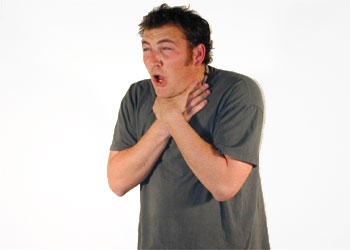Choking: First Aid
Choking often occurs when a foreign object gets stuck in the throat or windpipe. In adults, choking normally occurs due to food being lodged in the throat and in children, it occurs due to swallowing of small objects. Whether it is food, or a small object, the effect is the same; it cuts off the oxygen supply to the brain and can make a person unconscious. Therefore, prompt action must be taken and first aid must be administered to remove the obstruction.
Choking: Causes and symptoms
The following are the most common causes of choking:
- Swallowing large pieces of food without chewing properly
- Eating fast
- Talking and eating at the same time
- Dentures
- Walking or playing with your food while it is in the mouth
- Consumption of alcohol before eating
The sign that is universally understood to be the sign indicating choking is clutching the throat with the hand. If you did not see the victim giving this signal or you have detected the condition a bit later that the person is not conscious any more, then the following are the symptoms you should suspect for choking:

- Shortness of breath
- Noisy breathing
- Victim loses ability to cough
- The nails, skin and/or lips may turn blue due to the deprivation of oxygen
- The person may become unconscious
Treatment
St Mark James suggests using the ‘five-and-five’ approach on a choking person when you administer first aid.
- Give the victim 5 back blows between his shoulder blades using the heel of your hand.
- Next, give 5 abdominal thrusts or the Heimlich maneuver (see below).
- Now alternate the 5 blows and 5 thrusts till the obstruction is displaced.
Heimlich maneuver
After you have established that the person is choking, you may apply the Heimlich maneuver to dislodge the blockage.
- Stand behind the victim and wrap your hands around him as if you are giving him a hug
- Clench your right fist and place it right above his belly button
- Hold your right fist with your left hand and thrust inwards and upwards with great force
- Repeat this procedure until the person starts breathing or becomes unconscious
To perform abdominal thrusts on an unconscious person, you must:
- Bring the person to the floor and make him lay down with his back against the ground.
- Clear the airway by reaching the obstruction using your fingers. Do not push the blockage even deeper; just try to sweep it away.
- If the object does not budge or you can’t reach it, begin CPR. When you begin chest compressions, the pressure due to the compressions might be able to dislodge the object. Make sure you check the mouth within each cycle.
To perform abdominal thrusts on an obese or pregnant person, you must:
- Position your hands at the base of a breast bone (a bit higher than in normal abdominal thrusts), right above the meeting point of the lower ribs.
- Begin Heimlich maneuver by thrusting onto the chest
- Keep repeating until the airway is cleared or the person becomes unconscious
On an infant of less than 1 year, you must:
- Sit down and hold the child face down on your forearm, resting on your thigh.
- Press five times in the center of the back of the child. Do it gently but make sure you press firmly. This should dislodge the obstructed object.
- If this does not work, hold the child face-up on your forearm. Make sure the head is lower than the chest and place two of your fingers in the middle of the child’s breastbone. Give the child 5 chest compressions.
- Keep repeating the back blows and the chest compressions till the child starts breathing again. If this still does not work, call for medical help immediately.
- Till help arrives, begin CPR.
There are very high chances that you start choking and there will be no one around to help you. In such a situation it is advisable to call for immediate help, but you can perform the Heimlich maneuver yourself too:
- Clench your fist and place it a bit above your navel.
- Hold your fist with your other hand.
- Bend over on a hard object or surface, a chair would be perfect.
- Thrust in your fist inward and upward to dislodge the object from your airway.
Related Video on Infant Choking Victims

